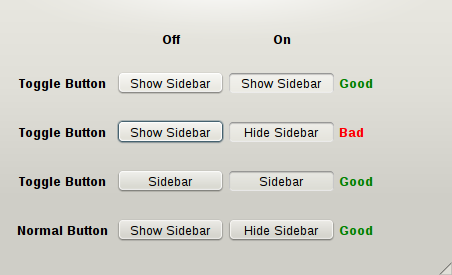Projects/Usability/HIG/Toggle Buttons: Difference between revisions
No edit summary |
|||
| Line 17: | Line 17: | ||
==How to Use== | ==How to Use== | ||
===Label | ===Icon and Label=== | ||
There are two ways to label a toggle button: | |||
1. Describe the state which is reached when the button is down: | |||
In this case the icon and label should not change when the button is down. | |||
For example a button to toggle the visibility of a sidebar could say "Show Sidebar". It should still say "Show Sidebar" when the button is down: it should not be changed to "Hide Sidebar". | |||
If you want to change the button text to "Hide Sidebar" when the sidebar is shown then you should use a normal button, not a toggle button. | |||
An alternative is to reduce the button to a noun if it is not ambiguous. In this example the button label could be reduced to "Sidebar". | |||
[[File:Toggle-button-summary.png]] | [[File:Toggle-button-summary.png]] | ||
2. Describe the '''current''' state: | |||
In this case the label will often include a passive verb. For example a button to lock or unlock an element would say "Unlocked" when it is up and "Locked" when it is down. The icon should match the label. | |||
Revision as of 22:04, 18 August 2010
Definition
A toggle button is a button which stays down when clicked once and goes up when clicked a second time.
When to Use
Use a toggle button to indicate a state.
Example: A word processor should use toggle buttons to indicate the state of "Bold", "Italic" or "Underline" formatting.
When not to Use
Do not use a toggle button to indicate an action.
Example: A music player should not use a toggle button to implement a combined Play/Pause button. It should use a normal button and adjust the icon and label to represent the action which would be performed when clicked.
How to Use
Icon and Label
There are two ways to label a toggle button:
1. Describe the state which is reached when the button is down:
In this case the icon and label should not change when the button is down.
For example a button to toggle the visibility of a sidebar could say "Show Sidebar". It should still say "Show Sidebar" when the button is down: it should not be changed to "Hide Sidebar".
If you want to change the button text to "Hide Sidebar" when the sidebar is shown then you should use a normal button, not a toggle button.
An alternative is to reduce the button to a noun if it is not ambiguous. In this example the button label could be reduced to "Sidebar".
2. Describe the current state:
In this case the label will often include a passive verb. For example a button to lock or unlock an element would say "Unlocked" when it is up and "Locked" when it is down. The icon should match the label.

